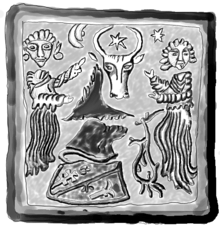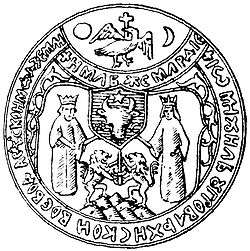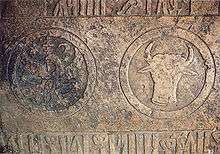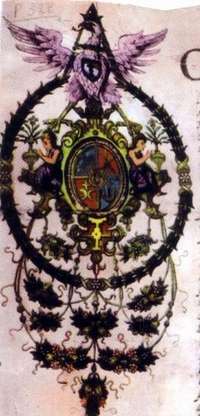Flag and coat of arms of Moldavia
 | |
| Name | Romanian: Cap de bour |
|---|---|
| Use | State and war flag |
| Proportion | 2:3 (?) |
| Design | Possible version of a Moldavian princely standard during Stephen the Great (attested versions of the number and general aspects of symbols other than the aurochs/wisent vary considerably) |
| Coat of arms of Moldavia | |
|---|---|
 | |
| Details | |
| Armiger | The Domn of Moldavia |
| Escutcheon | Gules, aurochs sable/or, rose, and crescent argent/or, five pointed star or |

The flag and coat of arms of Moldavia, one of the two Danubian Principalities, together with Wallachia, which formed the basis for the Romanian state, were subject to numerous changes throughout their history.
History
A princely standard was first attested under the rule of Prince Stephen the Great (late 15th century), depicting an or aurochs/wisent head (most likely alluding to the legends surrounding Moldavia's foundation by Dragoş), flanked by stylised figures of the Sun and crescent Moon (or other symbols, such as the rosette and star) set against a gules (or possibly purpure) background; its obverse displayed the figure of Saint George slaying the Dragon. The depiction of the Battle of Baia (1476) in Johannes de Thurocz's Chronicle shows Moldavian troops carrying a pennant with the aurochs head on pales of unspecified colour. In 1574, Moldavian delegates to the coronation of Henry III of Poland are attested to have carried a blue banner with the auroch's head.
Moldavia's fall under Ottoman Empire control, a process which was accelerated during the 16th century, saw a decline in flag usage; as princes became appointees of the Sultans, the usage of a sanjak as a mark of authority became widespread.
In the coat of arms (either seal or blazon), the aurochs was initially a crest over a helmet and party per pale escutcheon, charged with either fleur-de-lis dexter and bars sinister (interpreted as being alternating vert and or) or the Patriarchal cross dexter (closely resembling the Cross of Lorraine in usual renditions) and fleur-de-lis sinister. In time reduced to the simple depiction of an aurochs head on escutcheon, it was featured alongside the arms of Wallachia and Transylvania on Michael the Brave's seal, as well as only alongside Wallachia's on various symbols favored by rulers such as Radu Mihnea and several Phanariotes (in the latter case, it was more often than not accompanied by the double-headed eagle of Byzantine tradition).
The prevalent gules (or red) and or (yellow) display was replaced, towards the beginning of the 19th century, by variations on a red-blue theme. As such, when the Treaty of Adrianople allowed Wallachia and Moldavia a measure of sovereignty, Sultan Mahmud II awarded Moldavia a red over blue pennant to be used by its military, and Wallachia a yellow over blue one; Moldavia's pennant was similar to the version given recognition by Austria-Hungary as the Landesfarben of Bukovina (the latter was blue over red).
During the Organic Statute rule of Mihail Sturdza, the pennant was replaced by a war flag/naval ensign and a civil ensign with a blue field and a red canton standing for Ottoman suzerainty (see Ottoman Flag). Grigore Alexandru Ghica was to include the color yellow, already present in the pan-Romanian horizontal tricolour favored by the 1848 revolutionaries, in the war flag's pattern. In 1858, the aurochs became the central theme of the most valuable stamp in Romanian postal history, the Cap de Bour.
The aurochs head (dexter) and Wallachia's eagle (sinister) were included as emblems on the tricolour adopted by Alexandru Ioan Cuza after the union of the Danubian Principalities in 1859; the arms of Moldavia are nowadays represented in the coat of arms of Romania, as well as in that of the short-lived Moldavian Democratic Republic and present-day Moldova (having previously featured in the coat of arms of Bessarabia within the Russian Empire).
Gallery
-

Outline of an image on stove remains excavated at the Piatra Neamţ Fortress, showing the Wisent/Aurochs coat of arms of Moldavia
-

Coat of arms of Moldavia in 1481, carved on the walls of the Putna Monastery
-

Moldavian coat-of-arms, carved on the walls of Cetățuia Monastery in Iaşi.
-

Battle flag of Stephen the Great – Saint George slaying the Dragon
-

Moldavian flag in the Battle of Baia
-

Seal of Michael the Brave (showing the arms of Wallachia, Moldavia and Transylvania, as well as the stylised figures of Michael and his son)
-

Radu Mihnea's tombstone with the coats of arms of Wallachia and Moldavia (detail)
-

Elaborate arms of the Movileşti princely family, featuring Moldavia's coat of arms and colour theme
-

Page No. 2 of the Gospel Book (1723) printed during the reign of Nicholas Mavrocordatos. It shows the coats of arms of Moldavia (left) and Wallachia (right).
-

Cap de Bour stamp.
-
.svg.png)
Civil Ensign of the Principality of Moldavia in 1834–1861
References
| Wikimedia Commons has media related to Flag and coat of arms of Moldavia. |
- Principality of Moldavia and Wallachia and Moldavia, 1859–61 at Flags of the World
- (Romanian) Drapelul on the Romanian Presidency site
| |||||||||||||||||||||||||||||||||
